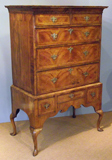Walnut was the most popular cabinet timber during the first quarter of the 18th century. Much prized by cabinetmakers for its strength and decorative figure, “Juglans Regia” or English walnut, was not in fact native to England, but was introduced from Europe, possibly by the Romans.
The “curl” figure is found where branches or roots separate from the main trunk; “burr” walnut, with its distinctive speckled grain, is actually cut from a growth or burr on the side of the tree. These decorative sections would only be used in veneer form, but walnut was also used in the solid for chairs etc.
Veneers from this period were laboriously cut by hand, and are typically 1/16th of an inch thick – paper thin veneers are one of the first indications of a Victorian copy, or a reproduction!
On this lovely chest on stand, dating from about 1740, the drawer fronts have been “quartered” – where four consecutive slices of veneer are laid out to mirror each other. These are framed by “featherbanding”, when two lines of banding are laid in a herringbone pattern. Oak or, as in this case, pine was the timber of choice for carcasses, as its strong tight grain provided a perfectly stable ground to support the fine veneers.
This lovely, faded “honey” colour is typical of an early period walnut piece.
